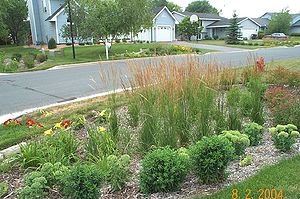
Difference between revisions of "Category:Level 3 - Best management practices/Structural practices/Bioretention"
m |
m |
||
| (2 intermediate revisions by the same user not shown) | |||
| Line 1: | Line 1: | ||
[[File:Burnsville rain garden 2.jpg|300px|thumb|alt=rain garden photo]] | [[File:Burnsville rain garden 2.jpg|300px|thumb|alt=rain garden photo]] | ||
[[File:Link image 2.jpg|200px|thumb|alt=link to bioretention page|[https://stormwater.pca.state.mn.us/index.php?title=Bioretention Link to Bioretention portal]]] | [[File:Link image 2.jpg|200px|thumb|alt=link to bioretention page|[https://stormwater.pca.state.mn.us/index.php?title=Bioretention Link to Bioretention portal]]] | ||
| + | |||
| + | <font size=5>[[Bioretention|'''Main page for Bioretention''']]</font size> | ||
{{alert|A rain garden, a term familiar to the general public, is a bioretention practice.|alert-info}} | {{alert|A rain garden, a term familiar to the general public, is a bioretention practice.|alert-info}} | ||
<span title="Bioretention is a terrestrial-based (up-land as opposed to wetland) water quality and water quantity control process. Bioretention employs a simplistic, site-integrated design that provides opportunity for runoff infiltration, filtration, storage, and water uptake by vegetation. Bioretention areas are suitable stormwater treatment practices for all land uses, as long as the contributing drainage area is appropriate for the size of the facility. Common bioretention opportunities include landscaping islands, cul-de-sacs, parking lot margins, commercial setbacks, open space, rooftop drainage and street-scapes (i.e., between the curb and sidewalk). Bioretention, when designed with an underdrain and liner, is also a good design option for treating Potential stormwater hotspots. Bioretention is extremely versatile because of its ability to be incorporated into landscaped areas. The versatility of the practice also allows for bioretention areas to be frequently employed as stormwater retrofits."> '''Bioretention practice'''</span> is a terrestrial-based (up-land as opposed to wetland) water quality and water quantity control process. Bioretention employs a simplistic, site-integrated design that provides opportunity for runoff infiltration, filtration, storage, and water uptake by vegetation. Bioretention is an important <span title="Green stormwater infrastructure (GSI) describes practices that use natural systems (or engineered systems that mimic or use natural processes) to capture, clean, and infiltrate stormwater; shade and cool surfaces and buildings; reduce flooding, create wildlife habitat; and provide other services that improve environmental quality and communities’ quality of life. (City of Tucson)"> '''green stormwater infrastructure'''</span> practice. | <span title="Bioretention is a terrestrial-based (up-land as opposed to wetland) water quality and water quantity control process. Bioretention employs a simplistic, site-integrated design that provides opportunity for runoff infiltration, filtration, storage, and water uptake by vegetation. Bioretention areas are suitable stormwater treatment practices for all land uses, as long as the contributing drainage area is appropriate for the size of the facility. Common bioretention opportunities include landscaping islands, cul-de-sacs, parking lot margins, commercial setbacks, open space, rooftop drainage and street-scapes (i.e., between the curb and sidewalk). Bioretention, when designed with an underdrain and liner, is also a good design option for treating Potential stormwater hotspots. Bioretention is extremely versatile because of its ability to be incorporated into landscaped areas. The versatility of the practice also allows for bioretention areas to be frequently employed as stormwater retrofits."> '''Bioretention practice'''</span> is a terrestrial-based (up-land as opposed to wetland) water quality and water quantity control process. Bioretention employs a simplistic, site-integrated design that provides opportunity for runoff infiltration, filtration, storage, and water uptake by vegetation. Bioretention is an important <span title="Green stormwater infrastructure (GSI) describes practices that use natural systems (or engineered systems that mimic or use natural processes) to capture, clean, and infiltrate stormwater; shade and cool surfaces and buildings; reduce flooding, create wildlife habitat; and provide other services that improve environmental quality and communities’ quality of life. (City of Tucson)"> '''green stormwater infrastructure'''</span> practice. | ||
| + | |||
| + | This page (category) provides links to pages that provide information on bioretention. Also included are links to photos, other images, and uploaded documents. | ||
[[Category:Level 2 - Best management practices/Structural practices]] | [[Category:Level 2 - Best management practices/Structural practices]] | ||
Latest revision as of 14:10, 12 February 2023
Bioretention practice is a terrestrial-based (up-land as opposed to wetland) water quality and water quantity control process. Bioretention employs a simplistic, site-integrated design that provides opportunity for runoff infiltration, filtration, storage, and water uptake by vegetation. Bioretention is an important green stormwater infrastructure practice.
This page (category) provides links to pages that provide information on bioretention. Also included are links to photos, other images, and uploaded documents.
Subcategories
This category has the following 2 subcategories, out of 2 total.
Pages in category "Level 3 - Best management practices/Structural practices/Bioretention"
The following 25 pages are in this category, out of 25 total.
B
C
O
R
- Rain gardens (bioretention) 101
- References for bioretention
- References for filtration
- Requirements, recommendations and information for using bioretention BMPs in the MIDS calculator
- Requirements, recommendations and information for using bioretention with an underdrain BMPs in the MIDS calculator
- Requirements, recommendations and information for using bioretention with no underdrain BMPs in the MIDS calculator
Media in category "Level 3 - Best management practices/Structural practices/Bioretention"
The following 16 files are in this category, out of 16 total.
- 130724 BioR-Details.dwg ; 659 KB
- Most Common Raingarden Weeds.pdf ; 410 KB
This page was last edited on 12 February 2023, at 14:10.

